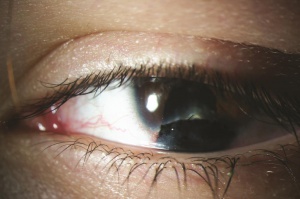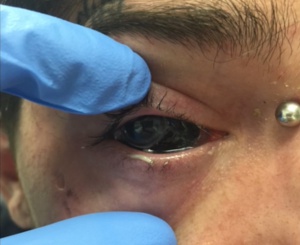Eye Tattooing
All content on Eyewiki is protected by copyright law and the Terms of Service. This content may not be reproduced, copied, or put into any artificial intelligence program, including large language and generative AI models, without permission from the Academy.
This article discusses the history, indications, techniques, and risks/benefits of eye tattooing procedures including both medically-indicated corneal tattooing, and purely cosmetic body modification practice of eyeball (subconjunctival/episcleral) tattooing.
Corneal tattooing
Introduction
Keratopigmentation or corneal tattooing is a procedure used for centuries to improve the cosmetic appearance of corneal scars and leukomas.[1] Keratopigmentation has been used to also treat visual symptoms associated with corneal and iris abnormalities. Several techniques have been developed using a variety of ink pigments to achieve the best functional and cosmetic results. More recently patients have been undergoing keratopigmentation to cosmetically change their eye color.
Indications

A valuable therapeutic alternative in a select group of patients in whom non-surgical (ex. contact lenses) and reconstructive surgical procedures will not result in functional or cosmetic improvement. Most common indications include corneal scars, leucomas, aniridia, polycoria, traumatic iris defects, and iridodialysis.[1][2][3][4] Other uses reported in the literature include symptomatic glare or diplopia associated with laser peripheral iridotomies[5] and intractable binocular diplopia.[6][7]
Techniques
Staining method: Direct application of tattoo ink to anterior surface of cornea. Benefits include fast procedure with uniform dye application. Limitations of this technique include relative impermeance of dye resulting in a high risk of fading.[2] Surgical marker can be used to directly stain the cornea to simulate the patient's improvement for therapeutic cases of symptomatic glare and diplopia.
Impregnation method: Tattoo pigment is directly introduced into the corneal tissue by needle puncture. Benefit is longer retention of pigment but more difficult and time consuming procedure. Irregularly placed pigment deposits can cause light scatter.[2]
Lamellar keratectomy technique: Benefits include longer retention of pigment and lower risk of recurrent corneal erosions. Panda et al. compared a series of patients who underwent conventional (impregnation) tattooing vs lamellar pocket procedure and noted greater pigment density, no episodes of erosion and none of the cases required repeat treatment at 1 year follow-up.[8]
Femto-assisted corneal tattooing (FACT): A femtosecond laser is used to make a superficial corneal pocket into which tattoo ink is injected.[9] The procedure enables the ink to last longer and achieve more uniform cosmetic results. Video of the technique by Dr Keith Walter performed using a femtosecond laser. https://www.aao.org/clinical-video/corneal-tattooing
Tattoo ink selection: Historically one of the major limitations of corneal tattooing has been the lack of systemic studies demonstrating biocompatibility of pigments and resulting unavailability of reliable commercial products. A variety of sterile ink formulations have been reported in the literature. Micronized mineral pigments are a relatively new pigment that has been shown to produce good cosmetic appearance without an inflammatory response and ocular toxicity.[10]
Complications
Complications of corneal tattooing include corneal infection, inflammation, pain, and risk of inadvertent globe penetration via entry into the anterior chamber. In a case series by Alio et al., keratopigmentation with micronized mineral pigments was performed in 234 eyes of 204 patients and percentage of complications was 12.82% of which the majority was light sensitivity (49%), color fading (19%), and neovascularization (7%).[11]
Histopathology
Several studies have looked at electron microscopy of corneal tattoo samples, and shown that electron dense granules are found within keratocytes and between collagen fibrils.[12][13][14] In histologic evaluation, Sekundo et al showed that keratocytes can retain tattoo particles of non-metallic dyes within their cell membrane for up to 61 years after corneal tattooing.[14]
Outcomes
Pitz et al. describe a case series of 11 patients suffering from corneal scars treated followed 4 years after surgery with satisfactory persistent staining of the corneal scar.[1] A retrospective study by Al-Shymali et al. of 136 eyes with cosmetically disabling corneal abnormalities showed high patient satisfaction (98.5%) following superficial keratopigmentation, though almost half (44.7%) needed a retouch procedure.[15]
“Eyeball” Tattooing (Subconjunctival / Episcleral)
Introduction

Eyeball tattoos are a relatively new form of cosmetic body modification.[16] In contrast to the corneal tattooing discussed above, this procedure is performed by non-ophthalmic trained individuals. A needle is used to inject tattoo dye under the bulbar conjunctiva. Dyes used for subconjunctival application are the same as the ones used for skin tattooing. There are significant short-term risks associated with this procedure, and the long term effects on eyes and vision are unknown given the given the recent popularity and lack of long term follow-up.
Individuals undergoing eyeball tattooing must be aware that the procedure may lead to numerous complications resulting in loss of vision and permanent damage to the eyes. Individuals must seek medical attention immediately if any symptoms develop. Eye care providers should also be aware of the increasing popularity of this practice as it may lead to increased frequency of presentation to acute eye care services.
Risks and Complications
Video describing complications of a case of scleral tattooing by Dr Paul R. Freund can be found at the following link. https://www.aao.org/clinical-video/scleral-tattoo-gone-wrong. An image from the video is shown in Figure 2.
Signs and symptoms preceding complications that have been reported in the literature include headaches, eye pain, photophobia and persistent foreign body sensation. Majority of complications are due to inadvertent eye penetration and intraocular pigment injection.
Globe penetration: Elevated risk of penetrating injury to the eye which may cause vitreous or subretinal hemorrhage, traumatic cataract and retinal detachment. Patients are at risk of infections such as endophthalmitis and orbital cellultis.[17] There has also been a case reported of penetrating ocular injury following self-administered ocular tattoos.[18]
Ink related reactions: Ink injected into the eye can migrate within the aqueous compartment resulting in coating of the lens, corneal endothelium and trabecular meshwork. Patients as a result may develop profound inflammatory foreign body reaction, uveitis, and/or secondary pigmentary glaucoma.[19] There is extensive literature into the immune complications of both dermal and periorbital tattoos such as uveitis.[20] Hypersensitivity reaction to the tattoo ink may present with nonspecific symptoms including swelling, tenderness, redness, pruiritis.[21][22] Treatment of subconjunctival hypersensitivity reaction involves topical and oral steroids and oral antihistamines.[21] Posterior scleritis and development of episcleral nodules have also been reported.[17]
References
- ↑ Jump up to: 1.0 1.1 1.2 Pitz, S. Corneal tattooing: an alternative treatment for disfiguring corneal scars. British Journal of Ophthalmology86, 397–399 (2002).
- ↑ Jump up to: 2.0 2.1 2.2 Burris, T. E., Holmes-Higgin, D. K. & Silvestrini, T. A. Lamellar intrastromal corneal tattoo for treating iris defects (artificial iris). Cornea17, 169–173 (1998).
- ↑ Remky, A., Redbrake, C. & Wenzel, M. Intrastromal corneal tattooing for iris defects. J Cataract Refract Surg24, 1285–1287 (1998).
- ↑ Reed, J. W. Corneal tattooing to reduce glare in cases of traumatic iris loss. Cornea13, 401–405 (1994).
- ↑ Islam, N. & Franks, W. A. Therapeutic corneal tattoo following peripheral iridotomy complication. Eye (Lond)20, 389–390 (2006).
- ↑ Dawson, E., Maino, A. & Lee, J. A Unique Use for a Corneal Tattoo. Strabismus17, 98–100 (2009).
- ↑ Stone, N. M., Somner, J. E. A. & Jay, J. L. Intractable diplopia: a new indication for corneal tattooing. Br J Ophthalmol92, 1445, 1561–1562 (2008).
- ↑ Panda, A., Mohan, M. & Chawdhary, S. Corneal tattooing--experiences with ‘lamellar pocket procedure’. Indian J Ophthalmol32, 408–411 (1984).
- ↑ Kim, J.-H., Lee, D., Hahn, T.-W. & Choi, S.-K. New surgical strategy for corneal tattooing using a femtosecond laser. Cornea28, 80–84 (2009).
- ↑ Amesty, M. A., Rodriguez, A. E., Hernández, E., De Miguel, M. P. & Alio, J. L. Tolerance of Micronized Mineral Pigments for Intrastromal Keratopigmentation: A Histopathology and Immunopathology Experimental Study. Cornea35, 1199–1205 (2016).
- ↑ Alio, J. L., Al-Shymali, O., Amesty, M. A. & Rodriguez, A. E. Keratopigmentation with micronised mineral pigments: complications and outcomes in a series of 234 eyes. Br J Ophthalmol102, 742–747 (2018).
- ↑ Olander, K., Kanai, A. & Kaufman, H. E. An analytical electron microscopic study of a corneal tattoo. Ann Ophthalmol15, 1046–1049 (1983).
- ↑ Sekundo, W., Seifert, P., Seitz, B. & Loeffler, K. U. Long-term ultrastructural changes in human corneas after tattooing with non-metallic substances. Br J Ophthalmol83, 219–224 (1999).
- ↑ Jump up to: 14.0 14.1 Fujita, H., Ueda, A., Nishida, T. & Otori, T. Uptake of india ink particles and latex beads by corneal fibroblasts. Cell Tissue Res.250, 251–255 (1987).
- ↑ Al-Shymali, O., Rodriguez, A. E., Amesty, M. A. & Alio, J. L. Superficial Keratopigmentation: An Alternative Solution for Patients With Cosmetically or Functionally Impaired Eyes. Cornea38, 54–61 (2019).
- ↑ Jenkins, K. S. & Layton, C. J. An eye for art? A challenge of ophthalmic body modification: Episcleral tattooing. Clinical & Experimental Ophthalmology44, 741–741 (2016).
- ↑ Jump up to: 17.0 17.1 Duarte, G., Cheja, R., Pachón, D., Ramírez, C. & Arellanes, L. Case series: Two cases of eyeball tattoos with short-term complications. Am J Ophthalmol Case Rep5, 26–28 (2017).
- ↑ Paulo, J. D., Turizo, J. C. M., Carrasquilla, D. C. M. & Bustamante, L. M. Self-inflicted injection of tattoo ink in the anterior chamber: a failed attempt to change the color of the eyes. Digit J Ophthalmol24, 10–12 (2018).
- ↑ Cruz, N. F. S. da, Santos, K. S., Farah, M. de L. & Felberg, S. Conjunctival Tattoo With Inadvertent Globe Penetration and Associated Complications. Cornea36, 625–627 (2017).
- ↑ Ostheimer, T. A. et al.Tattoo-associated uveitis. Am. J. Ophthalmol.158, 637-643.e1 (2014).
- ↑ Jump up to: 21.0 21.1 Kaur, R. R., Kirby, W. & Maibach, H. Cutaneous allergic reactions to tattoo ink. J Cosmet Dermatol8, 295–300 (2009).
- ↑ Kluger, N. Cutaneous and systemic complications associated with tattooing. Presse Med45, 567–576 (2016).

